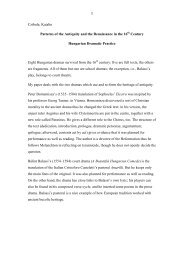Amir Weiner Getting to Know You
Amir Weiner Getting to Know You
Amir Weiner Getting to Know You
Create successful ePaper yourself
Turn your PDF publications into a flip-book with our unique Google optimized e-Paper software.
GETTING TO KNOW YOU 7<br />
Soviets’ own goals and evaluation? Finally, what do the surveillance methods<br />
tell us about the nature, goals, and distinct features of the regime when<br />
compared with other systems? 5<br />
We analyze the manner in which domestic surveillance was used in the<br />
application of key Sovietization policies and in coping with ensuing problems<br />
on the Soviet western frontier—the terri<strong>to</strong>ries between the Baltic and Black<br />
Seas, populated by some 23 million people—from their annexation in 1939–<br />
40 <strong>to</strong> the aftermath of the eventful year of 1956. Confronted by populations<br />
that enjoyed a brief spell of sovereignty during the interwar years, were hostile<br />
<strong>to</strong> Soviet power <strong>to</strong> the point of launching mass armed resistance, and posed<br />
linguistic and religious difficulties for infiltration, the Soviets pressed on<br />
relentlessly, imposing at once the political and socio-economic order that they<br />
gradually, sometimes even imperceptibly enforced over two decades inside<br />
the pre-1939 borders. Lest anyone entertained the thought that regional<br />
features required distinct policies, it was dismissed out of hand. “We work for<br />
the entire Union. There is no such thing as Ukraine in our work,” snapped<br />
Vitalii Fedorchuk, the direc<strong>to</strong>r of the Ukrainian KGB. 6 This tight temporal<br />
and geographical framework offers a unique window in<strong>to</strong> the functioning of<br />
the Soviet order as a whole, and in<strong>to</strong> its surveillance system in particular.<br />
<strong>Know</strong>ing Little, <strong>Know</strong>ing Much<br />
The birth of the Soviet surveillance system in the western borderlands was<br />
marked by a puzzle—the fantastic disparity between the limited knowledge<br />
of the local social scene and precise information on the political–military<br />
landscape by the intelligence agencies. The gap between Soviet servicemen’s<br />
and functionaries’ expectations and realities on the ground left one wondering<br />
what the Soviets actually knew about the terri<strong>to</strong>ries they had just annexed.<br />
An avalanche of servicemen’s letters, diaries, and memoirs, as well as their<br />
scrutiny by the party and police organs revealed a huge cohort that knew<br />
precious little about the neighboring populations who barely two decades<br />
5 Despite the passage of more than five decades and some outdated data, the Wolin and<br />
Schlusser volume cited above is still indispensable for studying the structure and functioning of<br />
the Soviet surveillance system. For a few exceptions in post-Soviet literature that address some<br />
of these issues, albeit with a different interpretation and temporal focus from that of this essay,<br />
see David Shearer, Policing Stalin’s Socialism: Repression and Social Order in the Soviet Union,<br />
1924–1953 (New Haven: Yale University Press, 2009); Paul Hagenloh, Stalin’s Police: Public<br />
Order and Mass Repression in the USSR, 1926–1941 (Baltimore: Johns Hopkins University<br />
Press, 2009); and the special issue “La police politique en Union Soviétique, 1918–1953,”<br />
Cahiers du monde russe 42, 2–3–4 (2001).<br />
6 Iakov Pogrebniak, Ne predam zabveniiu…: Zapiski professional´nogo partiinogo rabotnika<br />
(Kiev: Le<strong>to</strong>pis´-XX, 1999), 173–74.

















